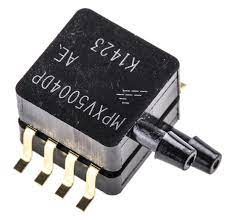MPXV5004DP
Part Number: MPXV5004DP
Manufacturer: NXP USA Inc
Description: SENSOR 0.57PSID 0.13″ 4.9V 8SOP
Shipped from: Shenzhen/HK Warehouse
Stock Available: Check with us
ICRFQ.com - Electronic Components Distributor in China Since 2003

Part Number: MPXV5004DP
Manufacturer: NXP USA Inc
Description: SENSOR 0.57PSID 0.13″ 4.9V 8SOP
Shipped from: Shenzhen/HK Warehouse
Stock Available: Check with us
| Datasheet | |
|---|---|
| Category | Sensors, Transducers |
| Family | Pressure Sensors, Transducers |
| Manufacturer | Freescale Semiconductor – NXP |
| Series | MPXV5004 |
| Part Status | Active |
| Pressure Type | Differential |
| Operating Pressure | 0.57 PSI (3.92 kPa) |
| Output Type | Analog Voltage |
| Output | 1 V ~ 4.9 V |
| Accuracy | – |
| Voltage – Supply | 4.75 V ~ 5.25 V |
| Port Size | Male – 0.13″ (3.3mm) Tube, Dual |
| Port Style | Barbed |
| Features | Temperature Compensated |
| Termination Style | PCB |
| Maximum Pressure | 2.32 PSI (16 kPa) |
| Operating Temperature | 0°C ~ 85°C |
| Package / Case | 8-SMD Module |
| Supplier Device Package | – |
A pressure sensor called the MPXV5004DP has a measurement range of 0.57 PSI (3.92 kPa) for differential pressure. It has a male connector for simple system integration and is made to be put onto a circuit board. The sensor measures the pressure difference between two ports using a piezoresistive transducer and can be applied to a variety of devices, including HVAC systems, medical equipment, and industrial controls.
High sensitivity, low power consumption, and compatibility with a broad range of input voltages are just a few of the MPXV5004DP’s standout qualities. It is simple to connect to a system and assure precise pressure measurements thanks to the two ports on the same side of the sensor. Additionally, it may be used in tough conditions thanks to its compact form factor and durable construction.
Freescale’s MPXV5004DP series piezoresistive transducer is a modern monolithic silicon pressure sensor for a range of applications, particularly those utilizing a microcontroller or microprocessor with A/D inputs. This sensor employs sophisticated micromachining techniques in addition to an implanted strain gauge that is extremely sensitive, thin-film metallization, and bipolar processing to produce an exact, high-level analog output signal that is proportional to the applied pressure.
A differential pressure sensor called the MPXV5004DP has a measurement range of 0.57 PSI (3.92 kPa). It operates in the 1V to 4.9V input voltage range and has a dual port design with same-side access. The sensor has a sensitivity of 20mV/kPa and outputs a linear voltage signal that is precisely proportional to the input pressure.
The MPXV5004DP offers the benefit of compact size and low power consumption when compared to other comparable pressure sensors, making it appropriate for usage in portable devices. Its dual port architecture makes installation and integration into current systems simple as well. But it might not have a wide enough measuring range for some high-pressure applications, and it might not be as accurate as other more expensive pressure sensors.
The MPXV5004DP stands out in comparison to other pressure sensors of a similar design because of its excellent sensitivity and low noise output. It is perfect for use in a wide range of industrial and automotive applications due to its extremely linear output and reliable performance across a wide temperature range. However, given that some applications need better pressure sensing capabilities, its modest maximum pressure range of 0.57 PSI might not be appropriate.
In general, the MPXV5004DP is a dependable and affordable option for a variety of pressure-sensing applications, particularly those that demand high sensitivity and low noise output.
Numerous industries use the MPXV5004DP pressure sensor, which has a wide range of uses. Here are a few instances:
The MPXV5004DP is an all-purpose pressure sensor that may be applied to a variety of situations. It is a great option for a variety of industries because of its small size, low power consumption, and high precision.
It is crucial to adhere to the suggested recommendations when developing an application circuit employing the MPXV5004DP to ensure proper performance. An instruction manual for designing an application circuit using the MPXV5004DP is provided below:
In conclusion, it is critical to carefully select the appropriate components, adhere to the suggested recommendations, and test and verify the operation of the circuit when constructing an application circuit utilizing the MPXV5004DP.
In conclusion, the MPXV5004DP pressure sensor is a versatile and reliable option for a wide range of pressure-sensing applications. Its excellent sensitivity, low power consumption, and compatibility with various input voltages make it a popular choice in several industries, including automotive, HVAC, medical, and consumer electronics. However, it is essential to keep in mind its maximum pressure range of 0.57 PSI when considering it for high-pressure applications. Following the suggested guidelines for designing an application circuit using the MPXV5004DP is crucial to ensure proper performance.
If you’re looking to order the MPXV5004DP or have any questions, don’t hesitate to reach out to our staff at ICRFQ. We offer competitive prices on high-quality electrical components and can provide experienced advice to help you get the parts you need for your project. Contact us today to get the assurance you need to start your project with confidence.
WhatsApp us